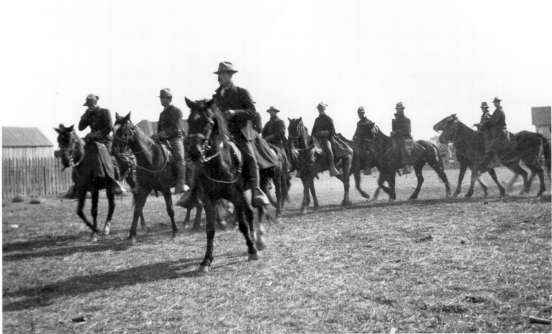
The Encyclopedia of Oklahoma History and Culture
HOFFMAN, ROY V. (1869–1953).
Roy V. Hoffman was born in Neosho County, Kansas, on June 13, 1869, to Peter S. and Julia Hoffman. After graduating from public schools, the younger Hoffman attended the Kansas Normal School in Fort Scott. In 1889 he moved with his family to the Sac and Fox Reservation in Indian Territory, and he settled in Guthrie soon thereafter. His father, Peter S. Hoffman, established the Union National Bank in Chandler.
During his lifetime Roy Hoffman worked at various jobs, including cowboy, teacher, newspaperman, public official, jurist, and soldier. He founded the Guthrie Daily Leader, the first daily newspaper in Oklahoma Territory, in 1889, and was admitted to the Oklahoma Bar Association in 1891. Hoffman married Estelle Conklin in 1898, and together they had four children. He was the private secretary to Oklahoma Territorial Gov. William C. Renfrow and became an assistant U.S. attorney in Oklahoma from 1903–07. He served as a judge for Oklahoma's Tenth Judicial District in 1908–12.
During the Spanish-American War Hoffman enlisted as a private in the Oklahoma Territory Battalion of the First Territorial Volunteer Infantry Regiment and was commissioned as captain. He was promoted to colonel in 1900 and was selected to command the First Infantry Regiment, Oklahoma National Guard. Gov. Charles N. Haskell ordered Hoffman to take his guardsmen and quell the Crazy Snake Uprising near Henryetta and Hitchita in 1910. In 1916 Hoffman served on the Mexican border where American troops were stationed to stop raids by Pancho Villa's troops.
When the United States entered World War I, Hoffman was the senior National Guard infantry colonel in the nation. He was transferred to the U.S. Army and promoted to brigadier general in August 1917 and was selected to command the Ninety-third Division (Colored). After organizing the unit, Hoffman took the Ninety-third to France, and from February through November 1918 he and his troops saw continuous front-line action.
Returning from France, Hoffman was assigned to command Camp Shelby in Mississippi. His last command was the Forty-fifth Infantry Division. Hoffman was instrumental in promoting and organizing a strong Oklahoma National Guard and has been called its "father." His military awards included the French Commander Legion of Honor, the French Colonial Decoration, the Commander of the Crown by Italy, and the American Distinguished Service Medal. He retired as a major general in 1933.
Hoffman was a charter member and an organizer of the American Legion, and he served as a national executive committee member for three terms. He was also the national vice president of the American Legion Founders and president of the National Reserve Officers' Association. For eighteen continuous years he served as the civilian aide to the secretary of war. A thirty-third degree Mason, he was also a member of other fraternal orders. He died at Oklahoma City on June 18, 1953, and was buried at Chandler.






